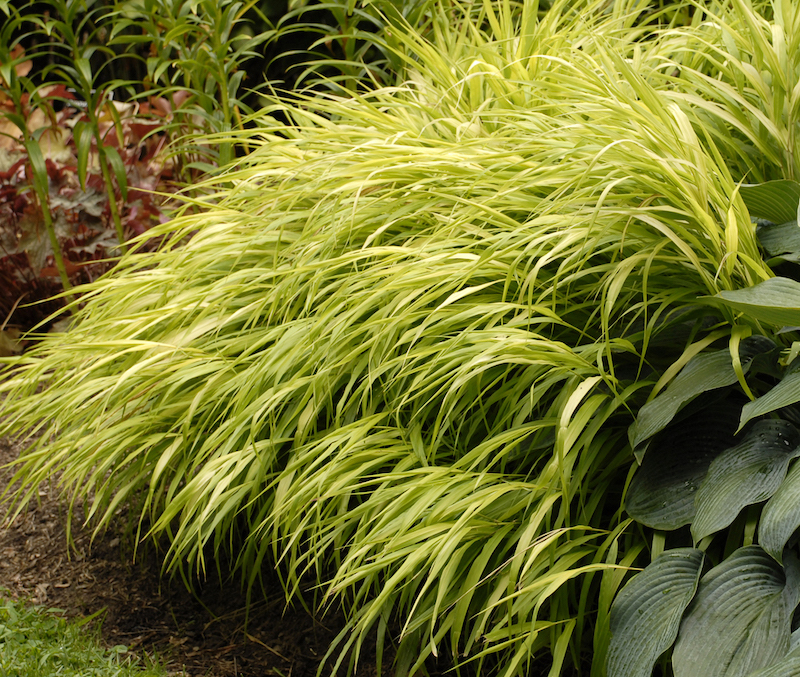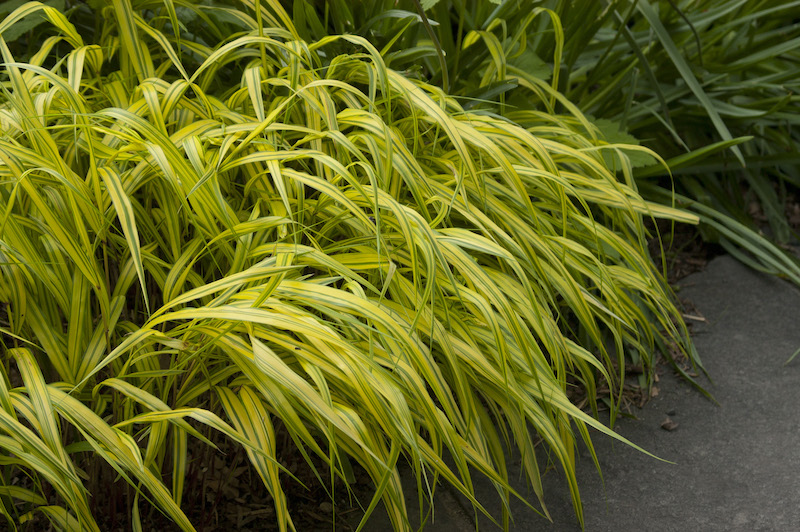Growing Japanese Forest Grass
Japanese forest grass, also known as Hakonechloa macra, is an elegant ornamental grass that thrives in shady, woodland gardens. It has a cascading mounded shape and comes in several color varieties including yellow, bright green, and variegated. This grass spreads slowly by underground rhizomes and takes time to establish. It blooms in mid-summer with inconspicuous inflorescences that do not produce viable seed.
Japanese forest grass prefers rich, moist soil with good drainage. These grasses form clumps approximately 2 – 3 feet tall and 3 feet wide. Plant them in drifts in a shady border or along a woodland path for the most striking effect.

Planting Japanese Forest Grass
Japanese forest grass performs best in partial to full shade and will bleach or burn in overly sunny sites. This grass can tolerate more sun in northern climates if kept consistently moist. It prefers rich, well-drained, moist soil.
To plant it, dig a hole just wide enough for the root ball, and set the the crown slightly above the soil surface to allow the soil to settle over time. Backfill the hole with native soil and water thoroughly to fill in any air gaps around the roots. Apply a thick layer of compost to keep the root zone cool and conserve moisture.

Watering Japanese Forest Grass
This grass requires regular water during the growing season and should not be allowed to dry out. Water it more frequently during hot, dry periods, and keep it protected from hot afternoon sun. Drip irrigation or soaker hoses are great options for applying water in a slow, targeted fashion with minimal evaporation. Containers dry out faster than plants in the ground and should be watered several times a week to keep the soil evenly moist.
Fertilizing Japanese Forest Grass
This ornamental grass may benefit from annual fertilizing depending on your soil content. Always test your soil first to determine if it is deficient in any critical nutrients. If nitrogen levels are low, you can apply a well-balanced (10-10-10 NPK), water-soluble formula at half strength in the spring. In addition, consider applying organic mulch around the base of the grass each spring to condition the soil.
Pruning Japanese Forest Grass
This herbaceous perennial will die back in the winter except in the warmest parts of its growing range. Leave the spent foliage in the winter to protect the crown from freezing temperatures. In the spring, cut back the spent foliage using a pair of sharp, sterilized pruning shears. Trim any sun-burnt leaves during the summer to keep this grass looking tidy.

Caring For Japanese Forest Grass in Pots
This grass looks fantastic in containers. Choose a weather-proof container with large drainage holes for plants grown outdoors. The container should be big enough to allow the roots to expand over the next year or two. Use potting soil that retains moisture but drains well to prevent root rot. Cover the roots with soil only to the depth that the grass was originally planted, and leave a couple inches at the top of the container for watering. Water regularly during the summer when the top inch of soil is dry to the touch, approximately 2 times per week.
Winter Care for Japanese Forest Grass
Japanese forest grass does not need any special winter care. During the winter, the foliage will turn yellow and eventually die back. You can leave the spent foliage for winter protection. At the northern end of its hardiness range, consider adding a thick layer of mulch to protect the roots from winter kill. In the spring, cut this grass back to a few inches above the ground. This is a long-lived perennial that should slowly expand each year.
Common Care Questions About Japanese Forest Grass
Does Japanese Forest Grass Tolerate Full Sun?
In cooler climates, Japanese Forest Grass can tolerate full sun. Exposure to sunlight will affect the color of the foliage, the more sun they get, the more cream-colored the leaves turn. In warmer zones, full sun means browning will occur. The more shade, the brighter green the grass will be.
Is Japanese Forest Grass Annual or Perennial?
Japanese Forest Grass is a hardy perennial that performs best in zones 5 through 9. It should be mulched to protect the roots during the winter months, in colder zones. It is deciduous and will die back to the ground.
Is Japanese Forest Grass Deer Resistant?
Japanese Forest Grass is both deer and rabbit resistant. They will brown elsewhere for something tastier!
Is Japanese Forest Grass Poisonous?
Japanese Forest Grass in non-toxic to humans (including children). It is not known to be toxic to your pets according to the ASPCA website, at this time, though there have been a few reported cases of allergic reactions to dogs, after ingestion.
Is Japanese Forest Grass Invasive?
Japanese Forest Grass is both a slow grower and a slow spreader, doing so by rhizomes. It is not considered to be at all invasive.
Japanese Forest Grass Isn't Blooming
The flowers of Japanese Forest Grass are insignificant and often not even noticeable. There is no reason to be concerned if you don't notice blooms. Providing rich, well-draining soil and keeping it consistently moist are optimal conditions to promote flowering.
Why Are The Leaves On Japanese Forest Grass Turning Yellow, Brown, and/or Black?
The most common reason for yellowing leaves on Japanese Forest Grass is by far, over-watering. Adjusting your watering schedule can easily remedy that; about an inch a week, over two or three waterings should do nicely. Yellowed leaves may also indicate a nutritional deficiency in the soil, magnesium, iron, sulfur, potassium, or nitrogen.
What Is The Growth Rate Of Japanese Forest Grass?
Japanese Forest Grass is considered to be a slow grower, meaning 12 inches or fewer, annually.
Is Japanese Forest Grass Drought Tolerant?
When established, they also tend to be slower growing, and less sun and drought tolerant.
Can You Divide Hakonechloa (Japanese Forest Grass?)
Hakonechloa can be split by tearing lifted clumps apart by hand. Cut down the foliage of Cortaderia Selloana (pampas grass) before dividing - making sure you wear stout clothing and gauntlet-style gloves. Keep divisions as large as possible.
Why Isn't Hakonechloa Growing?
Hakonechloa thrives in cool, moist conditions. When exposed to extreme temperatures and less humidity, it may not or eventually stop growing and may die.
How Do You Maintain Japanese Forest Grass?
The grass should be kept moist, but not soggy. Use mulch around the base of the plant to help conserve moisture. Hakonechloa doesn't require fertilizing in good soils but if you do fertilize, wait until after the first flush of growth in spring.
How Do You Prune Japanese Forest Grass?
This herbaceous perennial will die back in the winter except in the warmest parts of its growing range. Leave the spent foliage in the winter to protect the crown from freezing temperatures. In the spring, cut back the spent foliage using a pair of sharp, sterilized pruning shears. Trim any sunburnt leaves during the summer to keep this grass looking tidy.
Have a question about Japanese Forest Grass? Fill out the form below and we will try and get back to your question as soon as possible. We may even feature your question in this article to help other gardeners!
 |
Author Jessica Mercer - Published 7-13-2022 |
